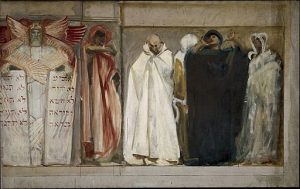The Prophets: Neviim
NEVI’IM (Prophets)

The section of the Hebrew Bible called the Nevi’im, or the Prophets, is subdivided into the books of:
- the Former Prophets (Joshua through 2 Kings, consisting of historical narratives featuring kings and prophets)
- and the books of the Latter Prophets (containing the oracles of the classical or literary prophets from the mid 8th to 5th centuries BCE). This canon of prophets, though somewhat fluid up to the early 2nd century BCE, was finally fixed by a council of rabbis at Jabneh (Jamnia) in Israel, c. 100 CE. The Christian list of the Prophets does not include the Former Prophets section in its division of the Prophets; instead, it calls the books in this section Historical Books.
- In addition to Isaiah, Jeremiah, and Ezekiel, the Christian list of the Prophets includes two works from the division known as the Ketuvim (the Writings): the Lamentations of Jeremiah and the Book of Daniel. The Twelve Prophets are separated into individual books, not clumped together as they are in the Hebrew Torah. Christian terminology calls one set of prophets Major (Isaiah, Jeremiah, Ezekiel, Daniel) and one Minor (the list of 12). This is not a division used in the Hebrew Bible.
The text will be using the Hebrew Bible terminology to look at the era of prophecy, which is considered to be the time period from the 11th to the 6th centuries BCE.
A. Former Prophets
Joshua: Relates the invasion of Canaan under Joshua and the distribution of the land to the Israelite tribes.
Judges: Stories that center around heroic “judges” who led the people in military victories over a variety of enemies.
1 Samuel: Samuel, the last judge and a prophet, reluctantly anoints a king at the behest of the people. Stories about the first king, Saul. and his rivalry with David.
2 Samuel: The story of King David. The rich Court History tells of his adulterous affair with Bathsheba and the revolt of his son Absalom.
l Kings: Relates David’s final years, and the reign of David’s son Solomon who builds a Temple to God in Jerusalem. Succession of the ten northern tribes to form the kingdom of Israel, leaving 2 southern tribes as the kingdom of Judah. The prophet Elijah zealously promotes Yahwism in the north and comes into conflict with King Ahab.
2 Kings: Stories about Elijah and his disciple, the prophet Elisha. Relates the overthrow of Ahab, the succession of kings in Israel until the final destruction of the northern country of Israel by the Assyrians in 722 B.C.E. Traces the history of the southern kingdom of Judah until the final destruction by the Babylonians in 587 B.C.E.
B. Latter Prophets
Isaiah: Oracles by and narratives about the late 8th century BCE northern prophet Isaiah (chapters 1-39). Chapters 40-66 are from a later period.
Jeremiah: Oracles, poems and narratives of the late 7th early 6th century BCE prophet Jeremiah. Jeremiah witnessed the end of the southern kingdom of Judah.
Ezekiel: Oracles and narratives of the early 6th century BCE prophet Ezekiel, written and delivered in Babylonia.
The Book of the Twelve: a collection of shorter prophetic books spanning from the 8th through the 6th centuries BCE.
1. Hosea -late 8th century BCE northern prophet
2. Joel- postexilic oracles focusing on a day of divine retribution
3. Amos – mid-8th century BCE northern prophet
4. Obadiah – post-destruction (post 587 BCE) prophet
5. Jonah – a short story about the prophet Jonah who is sent by God to Ninevah
6. Micah -late 8th century BCE Judean prophet
7. Nahum – a poem on the fall of Ninevah (late 7th century BCE)
8. Habbakuk – latter part of the 7th century BCE
9, Zephaniah — latter part of the 7th century BCE
10. Haggai -late 6th century BCE prophet, living at the time of the return from exile
II. Zechariah – combines late 6th century BCE visions with later postexilic materials
12. Malachi – 5th century BCE prophet.

May, Herbert G., et al. The New Oxford Annotated Bible with the Apocrypha: Revised Standard Version, Containing the Second Edition of the New Testament and an Expanded Edition of the Apocrypha. Edited by Michael D Coogan, Oxford University Press, 2007.
Gabel, John B. The Bible as Literature: An Introduction. Oxford University Press, 2006.
Christine Hayes, Introduction to the Old Testament, Yale University: Open Yale Courses, http://oyc.yale.edu (April 2022). License: Creative Commons BY-NC-SA Some materials here used from Yale University, copyright 2007 Some rights reserved. Unless otherwise indicated on this document or on the Open Yale Courses web site, all content is licensed under a Creative Commons License (Attribution-NonCommercial-ShareAlike 3.0).
